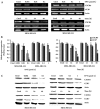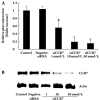Topotecan inhibits cancer cell migration by down-regulation of chemokine CC motif receptor 7 and matrix metalloproteinases
- PMID: 19363519
- PMCID: PMC4002819
- DOI: 10.1038/aps.2009.32
Topotecan inhibits cancer cell migration by down-regulation of chemokine CC motif receptor 7 and matrix metalloproteinases
Abstract
Aim: The aim of this study was to investigate the effect of topotecan (TPT) on cancer cell migration.
Methods: Growth inhibition of TPT was analyzed by MTT assay, and cancer cell migration was measured by transwell double chamber assay. To verify the effect of TPT on the chemokine receptors CXCR4 and CCR7, quantitative PCR, semi-quantitative PCR and Western blot analysis were performed. The secretion of MMP-2 and MMP-9 was detected by enzyme-linked immunosorbent assay (ELISA) and gelatin zymography. To evaluate possible contributions of CCR7 to MMP secretion, the overexpression vectors pcDNA3.1(+)-CCR7 and CCR7 siRNA were transiently transfected into MDA-MB-435 cells.
Results: TPT inhibited cancer cell migration in a dose-dependent manner. Additionally, TPT significantly decreased the expression of CCR7 in both MDA-MB-435 and MDA-MB-231 cells and moderately reduced the expression of CXCR4 in MDA-MB-435 cells. The secretion of MMPs (MMP-2, MMP-9) was also inhibited by TPT. Overexpression of CCR7 increased the secretion of MMP-2/9 and cancer cell migration, whereas knockdown of CCR7 reduced active MMP-2/9 production and migration of MDA-MB-435 cells.
Conclusion: TPT inhibited cancer cell migration by down-regulation of CCR7 and MMPs (MMP-2 and MMP-9).
Figures





Similar articles
-
MHP-1 inhibits cancer metastasis and restores topotecan sensitivity via regulating epithelial-mesenchymal transition and TGF-β signaling in human breast cancer cells.Phytomedicine. 2016 Sep 15;23(10):1053-63. doi: 10.1016/j.phymed.2016.06.013. Epub 2016 Jun 21. Phytomedicine. 2016. PMID: 27444351
-
Downregulation of the CXCR4/CXCL12 axis blocks the activation of the Wnt/β-catenin pathway in human colon cancer cells.Biomed Pharmacother. 2015 Apr;71:46-52. doi: 10.1016/j.biopha.2015.01.020. Epub 2015 Jan 15. Biomed Pharmacother. 2015. PMID: 25960214
-
Silencing of CCR7 inhibits the growth, invasion and migration of prostate cancer cells induced by VEGFC.Int J Clin Exp Pathol. 2015 Oct 1;8(10):12533-40. eCollection 2015. Int J Clin Exp Pathol. 2015. PMID: 26722441 Free PMC article.
-
Arctigenin, a lignan from Arctium lappa L., inhibits metastasis of human breast cancer cells through the downregulation of MMP-2/-9 and heparanase in MDA-MB-231 cells.Oncol Rep. 2017 Jan;37(1):179-184. doi: 10.3892/or.2016.5269. Epub 2016 Nov 23. Oncol Rep. 2017. PMID: 27878294
-
The CCL21/CCR7 pathway plays a key role in human colon cancer metastasis through regulation of matrix metalloproteinase-9.Dig Liver Dis. 2011 Jan;43(1):40-7. doi: 10.1016/j.dld.2010.05.013. Epub 2010 Jul 6. Dig Liver Dis. 2011. PMID: 20609636
Cited by
-
The selective anti-proliferative and pro-apoptotic effect of A. cherimola on MDA-MB-231 breast cancer cell line.BMC Complement Med Ther. 2020 Nov 13;20(1):343. doi: 10.1186/s12906-020-03120-1. BMC Complement Med Ther. 2020. PMID: 33187495 Free PMC article.
-
Interstitial flow influences direction of tumor cell migration through competing mechanisms.Proc Natl Acad Sci U S A. 2011 Jul 5;108(27):11115-20. doi: 10.1073/pnas.1103581108. Epub 2011 Jun 20. Proc Natl Acad Sci U S A. 2011. PMID: 21690404 Free PMC article.
-
Paclitaxel treatment enhances lymphatic metastasis of B16F10 melanoma cells via CCL21/CCR7 axis.Int J Biol Sci. 2022 Jan 24;18(4):1476-1490. doi: 10.7150/ijbs.67138. eCollection 2022. Int J Biol Sci. 2022. PMID: 35280672 Free PMC article.
References
-
- Thiery JP, Sleeman JP. Complex networks orchestrate epithelial mesenchymal transitions. Nat Rev Mol Cell Biol. 2006;7:131–42. - PubMed
-
- Chambers AF, Groom AC, MacDonald IC. Dissemination and growth of cancer cells in metastatic sites. Nat Rev Cancer. 2002;2:563–72. - PubMed
-
- Pienta KJ, Loberg R. The “emigration, migration, and immigration” of prostate cancer. Clin Prostate Cancer. 2005;4:24–30. - PubMed
-
- Leong SP, Cady B, Jablons DM, Garcia-Aguilar J, Reintgen D, Jakub J, et al. Clinical patterns of metastasis. Cancer Metastasis Rev. 2006;25:221–32. - PubMed
-
- Gupta SK, Lysko PG, Pillarisetti K, Ohlstein E, Stadel JM. Chemokine receptors in human endothelial cells: functional expression of CXCR4 and its transcriptional regulation by inflammatory cytokines. J Biol Chem. 1998;273:4282–7. - PubMed
Publication types
MeSH terms
Substances
LinkOut - more resources
Full Text Sources
Miscellaneous

